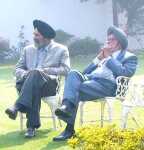Stories from Punjab

Having generations of roots in Punjab, Dr. Herbans Sidhu is unmistakably a Sikh.
Sikhism was founded about five hundred years ago by the tenth guru, Guru Gobenda Singh, as a monotheistic branch of Hinduism. The people were being raided at the time, invaded from the north, from Pakistan, and Guru Gobenda Singh taught the people to fight back. He taught them that they must become fearsome, like their enemies, even looking in some ways like their enemies.
He taught the Sikhs to protect their head in battle by wrapping a thick cloth around their head, the headdress known as the turban. He also taught his warriors to not shave, but to grow their facial hair to look more fearsome -- and at the same time to have as impeccable of hygiene as was possible when out in the field fighting. These traditions have carried on today in dress and tradition that is characteristic of the Sikhs of Punjab.
As I ask questions about Sikhism and Hinduism, those at the table are quick to defend their unity. One of the Hindus there speaks up. "God is one," he says. "But we people have tried to divide him."
The Sikhs' traditions are as strong as their family ties, and Dr. Sidhu is no exception.
Dr. Sidhu grew up in Burma. But during World War II, as Burma fell and as the British tried to retake the area, it became impossible to live there. So his family walked across the whole of India, to Punjab, where their relatives still lived. While the rest of the family survived the journey, the difficulties of travel proved too much for his father, and he was buried along the way.
As a young man, Dr. Sidhu received training as a physician before he was sent to practice on a desert island, a prison colony, 300 miles out in the Indian Ocean. When he returned to Punjab, he started his own hospital, working, as he put it, 24 hours a day doing all his own surgeries and visits. At last, he was able to expand Sidhu Hospital and add other physicians, where eventually his sons would join him in his practice.
It was in this same hospital that one of his sons would be kidnapped by Sikh extremists. Unable to convince them to release his son, Dr. Sidhu volunteered to be taken, too. They dumped him in a field and it was several days later that he and his son were finally reunited.
I could sit and listen to his stories of this fascinating region all night long, but it's late and I've pressed him long enough.
Dr. Sidhu is in his eighties and still practicing. He lives, as is custom, with his sons and their families. The success they have enjoyed over the years is the reason they can be so generous to us. Each of us is roomed in our own suite -- magnificent rooms with a marble bathroom attached to each bedroom. The house's lounge and beautiful teak-wood bar overlook the indoor pool. Outside, the courtyard is perfect for sitting in the sun and taking notes -- if, that is, we had more time to enjoy the Sidhus' generosity.
Instead we are leaving in the morning, another day full of being whisked away from meeting to meeting, and from one industry tour to another. Steel mills, honey factories, schools and universities, wheat farms, Rotary meetings, and one feast after another.
Though we are all tired, a busy schedule is the way it should be. Life is preciously short. New worlds are just around the corner waiting for us to open our eyes. They tempt us to step outside the comfort of our own skin and see life through new eyes, whether through stories told by our own grandfather, or stories told by a wise Sikh in Punjab.
